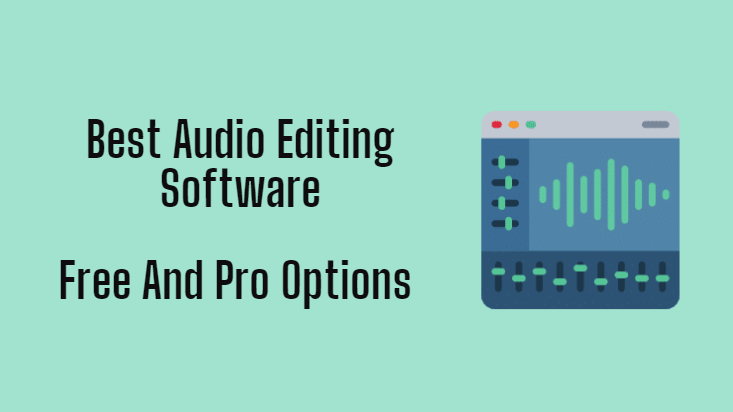Reviewed by: Jayprakash Prajapati | Last updated on February, 6, 2024
Want To Jump Straight To The Answer? The Best Audio Editing Software For Most People Is Adobe Audition, AVS Audio Editor, Or Audacity.
Audio editing software plays a pivotal role in the world of sound production, empowering musicians, podcasters, and audio enthusiasts to create, edit, and refine audio content. Whether you’re composing music, fine-tuning a podcast, or editing voice recordings, having the right audio editing software at your disposal is crucial. In this comprehensive guide, we’ll explore the realm of audio editing software, from its importance to key features, and how it enables users to craft, enhance, and perfect their sound.
Audio editing software is a digital tool that allows users to record, edit, and manipulate audio files, shaping them to meet various requirements.
I Want To Show You The Top-Range Audio Editing Software In 2024, Available On The Market Today, Reviewed In Deep Depth, And Help You Decide Which Is Best For Your Business.
What Is The Best Audio Editing Software.
Here Are My Picks For The Best Audio Editing Software To Use This Year.
1. Adobe Audition.
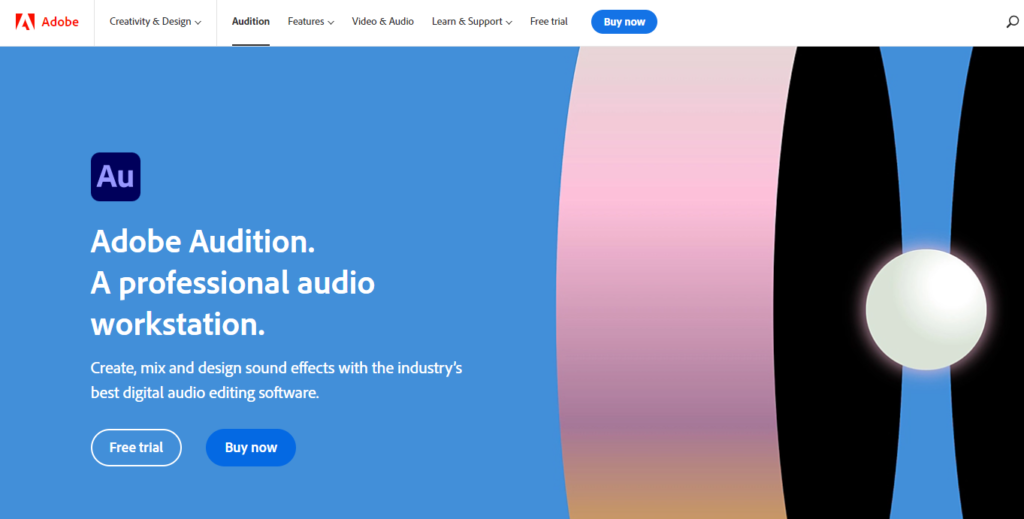
Adobe Audition is a comprehensive and versatile audio editing software that caters to a wide range of audio-related tasks, from simple audio editing and cleanup to complex multitrack music production and audio post-production for film and multimedia projects. Its extensive set of tools and seamless integration with the Adobe Creative Cloud ecosystem make it a go-to choice for audio professionals and enthusiasts.
Adobe Audition is a professional audio editing software developed by Adobe Inc. It’s widely used by audio engineers, musicians, podcasters, and sound designers for a range of audio-related tasks, including recording, editing, mixing, and mastering audio content. Here are some key features and functionalities of Adobe Audition as an audio editing software.
Key Features:
- Multitrack Editing: Adobe Audition provides a multitrack workspace where users can arrange and edit multiple audio clips or tracks simultaneously. This is essential for creating complex audio compositions.
- Waveform and Spectral Editing: Users can edit audio in both waveform and spectral views. Waveform editing allows for precise trimming and editing of audio clips, while spectral editing provides advanced tools for removing noise, correcting pitch, and enhancing audio quality.
- Audio Recording: Adobe Audition supports multi-channel audio recording from various sources, including microphones, instruments, and external audio interfaces. Real-time monitoring and punch-in recording are also available.
- Noise Reduction: The software offers advanced noise reduction tools to remove background noise, hum, clicks, and other unwanted artifacts from audio recordings.
- Audio Effects and Filters: Adobe Audition includes a vast library of built-in audio effects and filters, such as reverb, equalization, compression, and distortion. Users can apply these effects to individual tracks or the entire project.
- VST and AU Plugin Support: Users can expand the software’s capabilities by adding third-party VST and AU plugins, allowing for additional audio processing and effects options.
- Audio Restoration: Adobe Audition provides tools for audio restoration, allowing users to repair damaged or degraded audio recordings and restore them to better quality.
- Multichannel Audio: The software supports editing and mixing of multichannel audio, making it suitable for surround sound and immersive audio projects.
- Batch Processing: Users can automate repetitive tasks and apply changes to multiple audio files simultaneously using batch processing.
- Audio Analysis: Adobe Audition includes tools for analyzing audio, such as spectral frequency displays, amplitude statistics, and phase analysis, which can be helpful for diagnosing audio issues and making informed editing decisions.
- Integration with Adobe Creative Cloud: Adobe Audition seamlessly integrates with other Adobe Creative Cloud applications, allowing for easy import/export of audio assets between different Adobe software.
- Export Options: Finished audio projects can be exported in various formats, including WAV, MP3, AAC, and more, with options for setting bitrates and quality settings.
- Cross-Platform: Adobe Audition is available for both Windows and macOS operating systems.
- Podcast Production: Many podcasters use Adobe Audition for recording, editing, and producing their podcast episodes due to its powerful features and flexibility.
- Professional Audio Mixing and Mastering: Audio engineers and music producers use Adobe Audition for professional mixing and mastering of music tracks.
Pricing:
You can easily get started at Adobe Audition with a free sign-up. If you want more features besides free sign-up. So you will have to step up to the paid plan. If this plan does not match your personal reasons or business, I would recommend you to drop a mail to their customer support or you can contact them directly as per availability.
2. AVS Audio Editor.
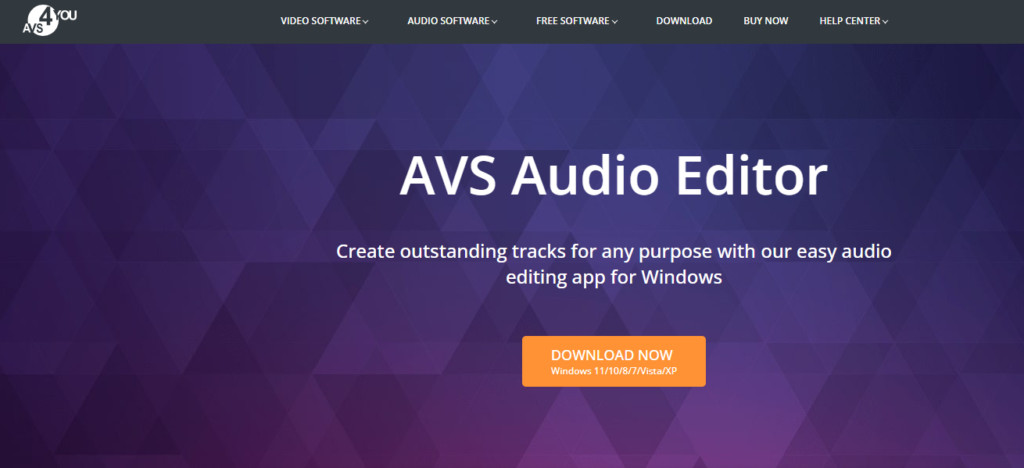
AVS Audio Editor is a versatile audio editing software that offers a range of tools and features for editing and enhancing audio files. Its user-friendly interface and support for various audio formats make it a suitable choice for individuals looking to perform basic to intermediate audio editing tasks, such as trimming, equalizing, and adding effects to audio files.
AVS Audio Editor is a user-friendly audio editing software that allows individuals to edit, enhance, and create audio files with ease. It provides a range of tools and features designed for both beginners and more experienced users. Here are some key features and functionalities of AVS Audio Editor as an audio editing software.
Key Features:
- Audio Editing: AVS Audio Editor provides a variety of editing tools, including cut, trim, copy, paste, and delete, allowing users to edit audio files with precision.
- Multitrack Editing: Users can work with multiple audio tracks simultaneously, making it suitable for tasks such as mixing music and creating podcasts.
- Audio Effects: The software offers a selection of built-in audio effects, including equalization, amplification, noise reduction, chorus, and reverb. Users can apply these effects to enhance the audio quality.
- Voice Recording: AVS Audio Editor includes a built-in voice recording feature, allowing users to record audio directly within the software.
- Audio Analysis: Users can view detailed audio analysis information, such as waveform and spectral frequency, to make informed editing decisions.
- Batch Editing: The software supports batch processing, enabling users to apply changes, effects, or conversions to multiple audio files simultaneously.
- Text-to-Speech Conversion: AVS Audio Editor allows users to convert text into speech and save it as an audio file.
- Audio Extraction: Users can extract audio tracks from video files, such as movies or video clips, and save them as separate audio files.
- Format Support: AVS Audio Editor supports a wide range of audio formats, including MP3, WAV, FLAC, M4A, AAC, and more, making it compatible with various audio devices and platforms.
- Crossfade Transitions: Users can create smooth audio transitions between tracks by applying crossfade effects.
- Audio CD Creation: The software enables users to create audio CDs from their edited audio files, complete with tracklists and CD-Text.
- Export Options: Finished audio projects can be exported in various formats, allowing users to choose the format that best suits their needs. Common formats like MP3 and WAV are supported.
- Ease of Use: AVS Audio Editor features an intuitive and user-friendly interface, making it accessible to users of all skill levels.
- Tutorials and Support: Users can access tutorials and documentation to learn more about the software and its features.
- Cross-Platform Compatibility: AVS Audio Editor is available for Windows operating systems.
Pricing:
You can easily get started at AVS Audio Editor with a free sign-up. If you want more features besides free sign-up. So you will have to step up to the paid plan. If this plan does not match your personal reasons or business, I would recommend you to drop a mail to their customer support or you can contact them directly as per availability.
3. Audacity.
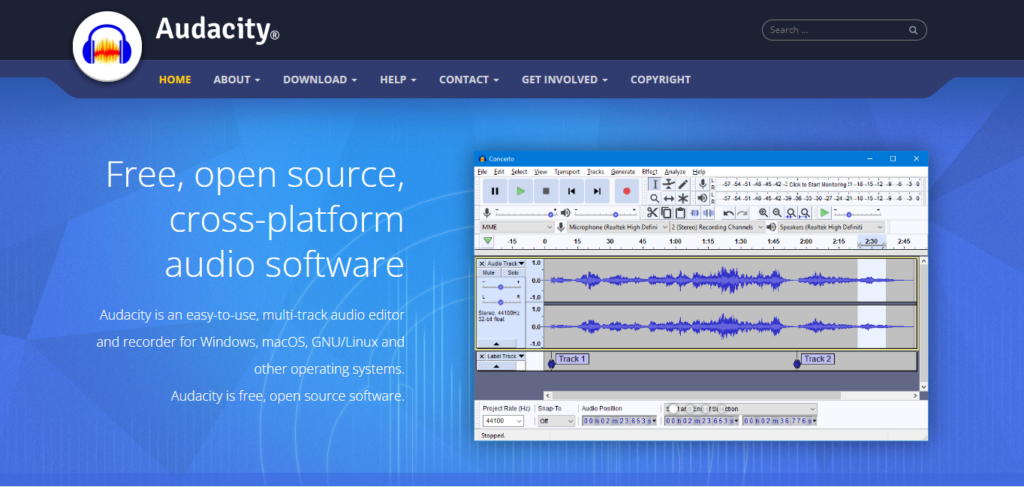
Audacity is a powerful and versatile audio editing software that is particularly well-suited for individuals and professionals seeking free and open-source solutions for audio recording and editing. Its robust feature set, extensive format support, and active user community have contributed to its popularity among a wide range of users in the audio industry.
Audacity is a popular and widely used open-source audio editing software that provides a comprehensive set of tools for recording, editing, and enhancing audio files. It is available for Windows, macOS, and Linux operating systems and is favored by a diverse community of users, including musicians, podcasters, audio engineers, and content creators. Here are some key features and functionalities of Audacity as an audio editing software.
Key Features:
- Multitrack Editing: Audacity supports multitrack audio editing, allowing users to work with multiple audio tracks simultaneously. This is essential for tasks like mixing music, editing podcasts, and creating soundscapes.
- Recording: Users can record audio directly within Audacity from a variety of sources, including microphones, instruments, and external audio interfaces. Real-time monitoring is available during recording.
- Editing Tools: Audacity offers a range of editing tools such as cut, copy, paste, delete, and trim, enabling users to edit audio files with precision.
- Audio Effects and Filters: The software includes a library of built-in audio effects and filters, including equalization, compression, noise reduction, reverb, and more. Users can apply these effects to enhance audio quality.
- VST Plugin Support: Audacity supports third-party VST plugins, allowing users to expand its capabilities with additional audio processing and effects options.
- Audio Analysis: Users can analyze audio using tools like the spectral frequency display, waveform view, and amplitude statistics, helping them identify and address issues in audio recordings.
- Noise Reduction: Audacity provides noise reduction tools to eliminate background noise, hum, hiss, and other unwanted artifacts from audio recordings.
- Batch Processing: Users can apply the same effects or changes to multiple audio files simultaneously through batch processing.
- Crossfade Transitions: Audacity enables the creation of smooth audio transitions between tracks using crossfade effects.
- Labeling and Markers: Users can add labels and markers to audio tracks for easier navigation and organization.
- Audio Format Support: Audacity supports a wide range of audio formats, including WAV, MP3, FLAC, AAC, and more, ensuring compatibility with various devices and platforms.
- Export Options: Finished audio projects can be exported in various formats, and users have control over settings like bitrates and quality levels.
- Accessibility: Audacity is designed with accessibility features, making it usable by individuals with visual or physical impairments.
- Community and Support: Audacity benefits from a large and active user community, and there is extensive online documentation, forums, and tutorials available for assistance.
- Cross-Platform Compatibility: Audacity is available for Windows, macOS, and Linux, making it accessible to users on different operating systems.
Pricing:
You can easily get started at Audacity with a free sign-up. If you want more features besides free sign-up. So you will have to step up to the paid plan. If this plan does not match your personal reasons or business, I would recommend you to drop a mail to their customer support or you can contact them directly as per availability.
4. AudioDirector 365.
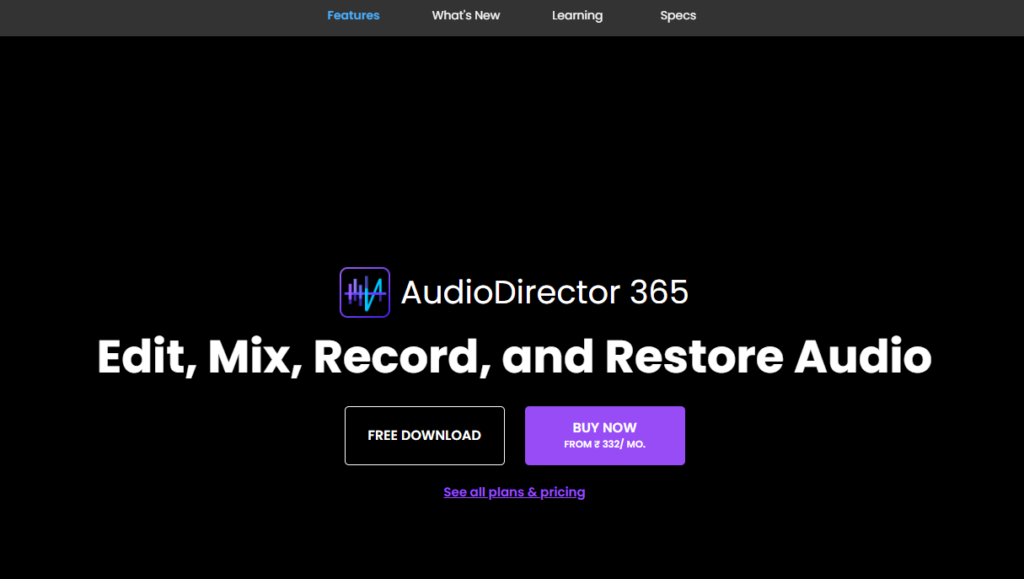
AudioDirector 365 is a powerful audio editing and sound design software that offers a range of features for audio professionals and multimedia creators. Its multitrack capabilities, audio effects, and comprehensive toolset make it a valuable asset for audio post-production, music production, and sound design in various creative industries.
AudioDirector 365 is a comprehensive audio editing and sound design software offered as part of CyberLink’s subscription-based creative suite. It’s designed for individuals and professionals in audio production, film, video, and multimedia industries. AudioDirector 365 offers a range of powerful tools and features for recording, editing, enhancing, and mixing audio content. Here are some key features and functionalities of AudioDirector 365 as an audio editing software.
Key Features:
- Multitrack Editing: Users can work with multiple audio tracks simultaneously in a multitrack environment, making it suitable for tasks such as audio mixing, film post-production, and music production.
- Recording: AudioDirector 365 supports audio recording from various sources, including microphones, instruments, and external audio interfaces. Real-time monitoring and punch-in recording are available.
- Audio Effects and Filters: The software provides a wide selection of audio effects and filters, including equalization, compression, noise reduction, reverberation, and modulation effects. Users can apply these effects to enhance audio quality and creativity.
- VST Plugin Support: AudioDirector 365 supports VST plugin integration, allowing users to expand the software’s capabilities with third-party audio processing plugins and virtual instruments.
- Surround Sound Mixing: Users can create and mix audio in surround sound formats, including 5.1 and 7.1, making it suitable for immersive audio experiences in films and games.
- Audio Restoration: The software includes tools for audio restoration, enabling users to repair and enhance damaged or low-quality audio recordings.
- Voice and Dialogue Enhancement: AudioDirector 365 offers specialized tools for enhancing voice and dialogue in audio recordings, including noise reduction, de-essing, and pitch correction.
- Frequency Spectrum View: Users can visualize and edit audio in the frequency spectrum, allowing for precise control over audio frequencies and addressing issues like unwanted background noise.
- Time Stretching and Pitch Shifting: AudioDirector 365 provides time stretching and pitch-shifting capabilities, allowing users to adjust the tempo and pitch of audio without affecting its quality significantly.
- Audio Analysis: Users can analyze audio using tools like spectral frequency displays, waveforms, and audio statistics, aiding in audio diagnosis and editing decisions.
- Batch Processing: The software supports batch processing, making it possible to apply changes, effects, or conversions to multiple audio files simultaneously.
- Audio Format Support: AudioDirector 365 supports a range of audio formats, including WAV, MP3, AAC, FLAC, and more, ensuring compatibility with various platforms and devices.
- Export Options: Finished audio projects can be exported in various formats, and users can configure settings like bitrates, sample rates, and channel configurations.
- Cross-Platform Compatibility: AudioDirector 365 is compatible with Windows operating systems.
- Subscription Model: AudioDirector 365 is part of CyberLink’s subscription-based service, which provides users with ongoing updates, access to additional features, and premium content libraries.
Pricing:
You can easily get started at AudioDirector 365 with a free sign-up. If you want more features besides free sign-up. So you will have to step up to the paid plan. If this plan does not match your personal reasons or business, I would recommend you to drop a mail to their customer support or you can contact them directly as per availability.
5. PreSonus Studio One.

PreSonus Studio One is a feature-rich and user-friendly audio editing software that caters to musicians, producers, and audio professionals across various genres and industries. Its seamless integration of recording, editing, mixing, and mastering tools in a single environment makes it a versatile choice for audio and music production tasks.
PreSonus Studio One is a professional-grade digital audio workstation (DAW) and audio editing software designed for musicians, producers, recording engineers, and other audio professionals. It offers a comprehensive set of tools and features for recording, editing, mixing, and mastering audio and music. Here are some key features and functionalities of PreSonus Studio One as an audio editing software.
Key Features:
- Intuitive User Interface: Studio One is known for its user-friendly and intuitive interface, making it accessible to both beginners and experienced audio professionals.
- Multitrack Editing: Users can work with multiple audio and MIDI tracks in a multitrack environment, allowing for complex music compositions, audio mixing, and editing.
- Recording: Studio One supports multi-channel audio recording from various sources, including microphones, instruments, and external audio interfaces. It offers real-time monitoring and punch-in recording.
- MIDI Sequencing: The software includes robust MIDI sequencing capabilities, enabling users to create and edit MIDI tracks, including virtual instruments and MIDI controllers.
- Audio Effects and Virtual Instruments: Studio One features a wide range of built-in audio effects, virtual instruments, and instrument libraries. Users can apply these effects and instruments to enhance audio quality and creativity.
- VST and AU Plugin Support: Studio One supports third-party VST and AU plugins, allowing users to extend its functionality with additional audio processing plugins and virtual instruments.
- Mixing and Mastering: The software offers a powerful mixing console with advanced features like automation, channel strip effects, and bussing options. Users can also master their tracks within the same environment.
- Audio Analysis: Studio One provides various tools for audio analysis, including spectral frequency displays, waveforms, and audio statistics, aiding in the diagnosis and editing of audio issues.
- Melodyne Integration: Studio One seamlessly integrates Celemony’s Melodyne pitch correction and manipulation software, providing advanced pitch editing capabilities.
- Time Stretching and Pitch Shifting: Users can adjust the tempo and pitch of audio and MIDI in real-time without significant loss of quality.
- Arranger Track: The Arranger Track allows users to experiment with song arrangements easily, making it an excellent tool for songwriters and composers.
- Project Page: Studio One’s Project Page is dedicated to mastering and finalizing projects, with features like CD burning, DDP export, and loudness metering.
- Crossfade Editor: Studio One offers a flexible crossfade editor for creating smooth transitions between audio events.
- Audio Format Support: The software supports a wide range of audio formats, including WAV, MP3, FLAC, AAC, and more.
- Cross-Platform Compatibility: Studio One is available for both Windows and macOS operating systems.
- Community and Support: PreSonus has an active user community, extensive online documentation, and customer support resources.
Pricing:
You can easily get started at PreSonus Studio One with a free sign-up. If you want more features besides free sign-up. So you will have to step up to the paid plan. If this plan does not match your personal reasons or business, I would recommend you to drop a mail to their customer support or you can contact them directly as per availability.
6. FL Studio.
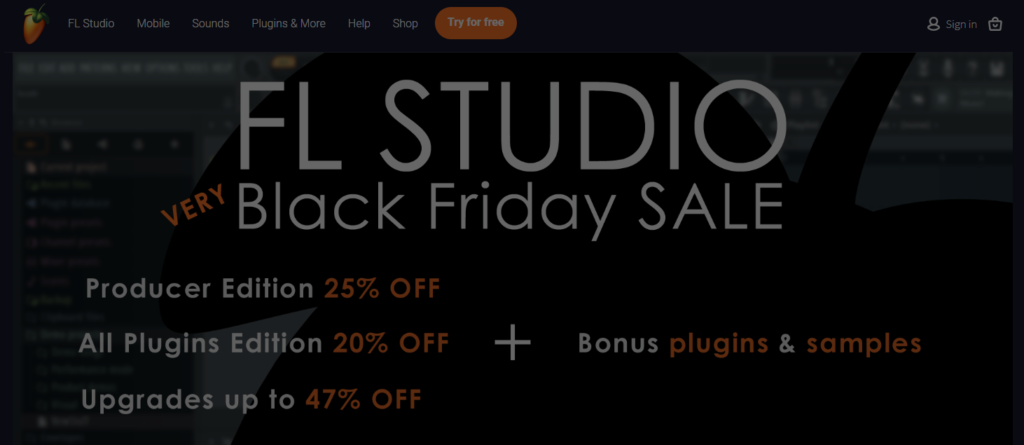
FL Studio is a powerful and flexible audio editing and music production software that is particularly well-suited for electronic music genres but can be used for a wide range of musical styles. Its pattern-based workflow, extensive virtual instrument library, and support for third-party plugins make it a favorite choice among music producers and creators.
FL Studio, formerly known as FruityLoops, is a versatile digital audio workstation (DAW) and music production software developed by Image-Line. It’s a popular choice among music producers, musicians, and DJs for creating, recording, editing, and arranging music and audio. FL Studio stands out for its unique workflow and extensive feature set. Here are some key features and functionalities of FL Studio as an audio editing and music production software.
Key Features:
- Pattern-Based Sequencing: FL Studio uses a pattern-based sequencing approach, which allows users to create and arrange musical patterns in a non-linear fashion. This is particularly useful for electronic music genres.
- Multi-Track Recording: Users can record multiple audio and MIDI tracks simultaneously, making it suitable for recording live instruments and vocals.
- Step Sequencer: FL Studio’s step sequencer is a powerful tool for creating drum patterns, melodies, and basslines with precision.
- MIDI Editing: The software provides comprehensive MIDI editing capabilities, including piano roll, event editor, and automation clips for fine-tuning MIDI data.
- Audio Clips: Users can work with audio clips directly on the playlist, enabling easy arrangement and manipulation of audio recordings.
- Audio Effects and Instruments: FL Studio includes a vast library of built-in audio effects, synthesizers, and virtual instruments, such as synthesizers, samplers, and drum machines.
- VST and AU Plugin Support: Users can expand their sound palette by adding third-party VST and AU plugins, including virtual instruments and audio effects.
- Mixing and Effects: FL Studio offers a fully featured mixer with audio routing, channel effects, and extensive audio effects like EQ, compression, reverb, and more.
- Automation: Users can automate nearly every parameter within FL Studio, allowing for dynamic changes and intricate sound design.
- Time-Stretching and Pitch-Shifting: The software provides high-quality time-stretching and pitch-shifting algorithms, allowing users to manipulate audio without compromising quality.
- Audio Slicing and Warping: FL Studio offers powerful audio manipulation tools, including slicing, warping, and audio quantization, for creative sound design.
- Live Performance: Many DJs and live performers use FL Studio due to its live performance features, including clip launching and MIDI controller support.
- Score and Notation: Users can create and edit musical scores and notations within FL Studio, making it suitable for composers and arrangers.
- Cross-Platform Compatibility: FL Studio is available for both Windows and macOS operating systems.
- Lifetime Free Updates: Users who purchase FL Studio receive lifetime free updates, ensuring they have access to the latest features and improvements.
- Community and Support: FL Studio has a vibrant user community, extensive online tutorials, and official support resources.
Pricing:
You can easily get started at FL Studio with a free sign-up. If you want more features besides free sign-up. So you will have to step up to the paid plan. If this plan does not match your personal reasons or business, I would recommend you to drop a mail to their customer support or you can contact them directly as per availability.
7. Sound Forge Audio Studio.
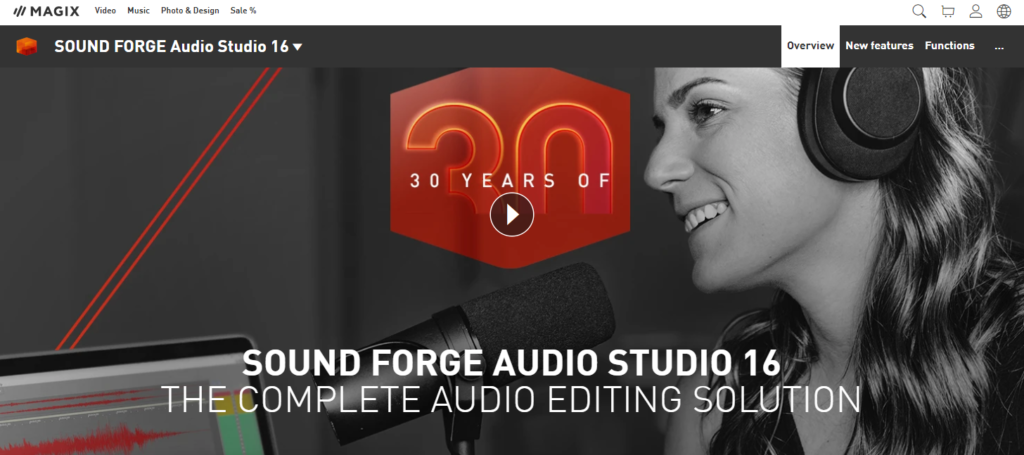
Sound Forge Audio Studio is a user-friendly audio editing software that provides essential tools and features for audio recording, editing, and mastering. Its intuitive interface and support for various audio formats make it suitable for users looking to perform basic to intermediate audio editing tasks, such as editing recordings, applying effects, and preparing audio for various applications.
Sound Forge Audio Studio is a popular and user-friendly audio editing software developed by MAGIX. It’s designed for individuals and home studio enthusiasts looking to record, edit, and produce high-quality audio. Sound Forge Audio Studio offers a range of tools and features for audio editing and mastering. Here are some key features and functionalities of Sound Forge Audio Studio as an audio editing software.
Key Features:
- User-Friendly Interface: Sound Forge Audio Studio is known for its straightforward and intuitive user interface, making it accessible to users of all skill levels.
- Multitrack Editing: Users can work with multiple audio tracks in a multitrack environment, allowing for more complex audio projects and mixing.
- Recording: The software supports multi-channel audio recording from various sources, including microphones, instruments, and external audio interfaces. Real-time monitoring is available during recording.
- Audio Effects and Filters: Sound Forge Audio Studio provides a variety of built-in audio effects and filters, such as equalization, reverb, chorus, and noise reduction. These effects can be applied to enhance audio quality.
- VST Plugin Support: Users can extend the software’s capabilities by adding third-party VST plugins, allowing for additional audio processing and creative effects.
- Audio Restoration: Sound Forge Audio Studio includes tools for audio restoration, enabling users to clean up and enhance noisy or damaged audio recordings.
- Audio Analysis: Users can visualize and analyze audio with tools like waveform displays, spectral frequency analysis, and audio statistics.
- Batch Processing: The software supports batch processing, allowing users to apply changes, effects, or conversions to multiple audio files simultaneously.
- Crossfade Editor: Users can create smooth audio transitions between clips with the crossfade editor, providing seamless transitions between audio segments.
- CD Burning: Sound Forge Audio Studio allows users to create audio CDs directly from their edited audio projects, complete with tracklists and CD-Text.
- Audio Format Support: The software supports a wide range of audio formats, including WAV, MP3, FLAC, AAC, and more, ensuring compatibility with various platforms and devices.
- Export Options: Finished audio projects can be exported in various formats and quality settings to suit the user’s needs.
- Cross-Platform Compatibility: Sound Forge Audio Studio is available for Windows operating systems.
- Tutorials and Support: Users can access tutorials and documentation to learn more about the software’s features and functionality.
Pricing:
You can easily get started at Sound Forge Audio Studio with a free sign-up. If you want more features besides free sign-up. So you will have to step up to the paid plan. If this plan does not match your personal reasons or business, I would recommend you to drop a mail to their customer support or you can contact them directly as per availability.
8. GarageBand.
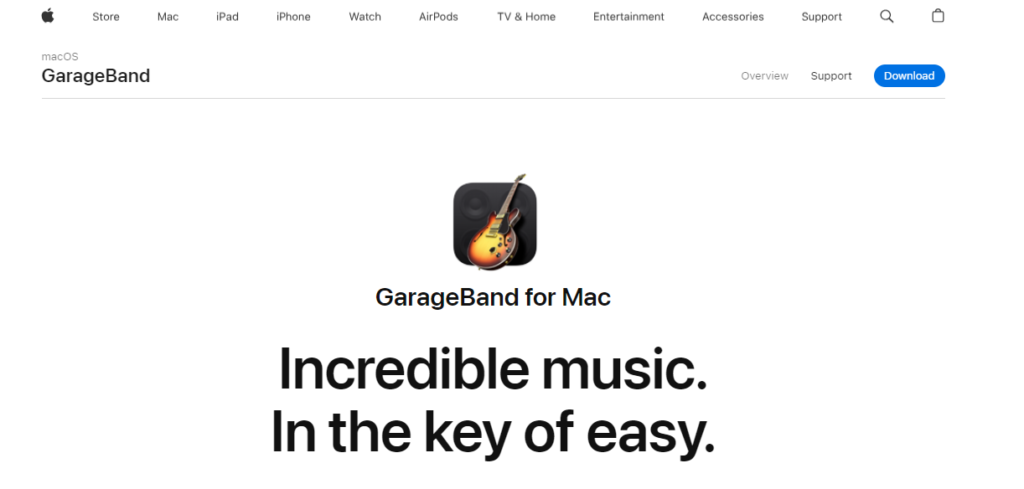
GarageBand is a versatile and beginner-friendly audio editing and music production software that is widely used by Mac and iOS users. Its combination of virtual instruments, recording capabilities, and easy-to-use interface makes it an excellent choice for musicians, podcasters, and creative individuals who want to create high-quality audio content.
GarageBand is a user-friendly digital audio workstation (DAW) and music production software developed by Apple Inc. It is designed for musicians, music producers, podcasters, and other creative individuals looking to create and edit audio and music on macOS and iOS devices. GarageBand offers a range of features and tools for recording, editing, and producing audio content. Here are some key features and functionalities of GarageBand as an audio editing software.
Key Features:
- User-Friendly Interface: GarageBand is known for its intuitive and user-friendly interface, making it accessible to beginners and experienced users alike.
- Multitrack Recording: Users can record multiple audio and MIDI tracks simultaneously, allowing for versatile music and audio production.
- Virtual Instruments: GarageBand includes a wide selection of virtual instruments, such as pianos, guitars, drums, and synthesizers, enabling users to create music without physical instruments.
- Audio Recording: Users can record audio from various sources, including microphones, instruments, and external audio interfaces, with support for real-time monitoring.
- MIDI Sequencing: The software offers MIDI sequencing capabilities, allowing users to create and edit MIDI tracks, including note editing, automation, and virtual instrument integration.
- Smart Controls: GarageBand provides intuitive controls for adjusting instrument and effect parameters, making it easy to shape the sound of virtual instruments.
- Audio Effects: Users can apply a range of built-in audio effects, including equalization, compression, reverb, and delay, to enhance audio quality and creativity.
- Drummer and Beat Sequencer: GarageBand features virtual drummers that can be customized to create realistic drum tracks. The Beat Sequencer allows for the creation of custom drum patterns.
- Live Loops: Live Loops enables users to create music by triggering loops and samples in real-time, making it suitable for electronic music production and live performances.
- Automation: Users can automate parameters for instruments and effects to create dynamic changes in their music and audio projects.
- Podcast Creation: GarageBand includes podcast-specific features, such as templates, voice recording, and royalty-free sound effects, making it a popular choice among podcasters.
- Score Editor: The software provides a score editor for notating and composing music, making it useful for composers and arrangers.
- Audio Format Support: GarageBand supports various audio formats, including WAV, AIFF, MP3, and more, for export and sharing.
- Cross-Platform Compatibility: GarageBand is available for macOS and iOS devices, allowing users to work seamlessly between desktop and mobile.
- iCloud Integration: Users can save and sync GarageBand projects across their Apple devices via iCloud.
- Educational Resources: GarageBand offers educational resources, tutorials, and lessons for users who want to learn music production and audio editing.
Pricing:
You can easily get started at GarageBand with a free sign-up. If you want more features besides free sign-up. So you will have to step up to the paid plan. If this plan does not match your personal reasons or business, I would recommend you to drop a mail to their customer support or you can contact them directly as per availability.
9. Descript.

Descript is an innovative audio and multimedia editing software that simplifies the editing process through its text-based approach. It’s particularly useful for content creators who want a more intuitive and visual way to edit audio and video content. Its collaborative features and cloud-based storage make it a valuable tool for teams and individuals working on multimedia projects.
Descript is a cutting-edge audio and multimedia editing software that goes beyond traditional audio editing. It’s designed for content creators, podcasters, video editors, and anyone who works with audio and video content. Descript offers a unique approach to editing, focusing on a text-based editing workflow that allows users to edit audio and video as easily as editing text. Here are some key features and functionalities of Descript as an audio editing software.
Key Features:
- Text-Based Editing: Descript allows users to edit audio and video by simply editing the corresponding transcript. You can delete words, sentences, or paragraphs from the transcript, and the corresponding audio or video is automatically edited accordingly. This makes the editing process more intuitive and visual.
- Multitrack Editing: Users can work with multiple audio and video tracks simultaneously, making it suitable for complex audio and video projects.
- Voice Editing: Descript includes features for voice editing, such as overdubbing, pitch correction, and noise reduction, allowing users to improve audio quality and clarity.
- Transcription and Voice Recognition: The software provides automatic transcription and voice recognition capabilities, making it easy to create accurate transcripts of audio and video content.
- Screen Recording: Descript includes a screen recording feature, allowing users to record and edit video content directly within the software.
- Collaboration: Descript offers collaboration tools that enable multiple users to work on the same project simultaneously. Users can leave comments, make edits, and provide feedback within the platform.
- Text-to-Speech: Users can convert text into lifelike speech using Descript’s text-to-speech feature, which is useful for creating narration or voiceovers.
- Audio Effects: The software includes a range of audio effects and filters, such as EQ, compression, and reverb, for enhancing audio quality.
- Export Options: Finished projects can be exported in various formats, including audio, video, and text formats, to suit different distribution platforms.
- Cross-Platform Compatibility: Descript is available for both macOS and Windows operating systems, making it accessible to a wide range of users.
- Cloud-Based Storage: Descript offers cloud-based storage and syncing, allowing users to access their projects from multiple devices and collaborate with team members.
- Educational Resources: The platform provides tutorials and educational resources to help users learn how to make the most of its features and capabilities.
Pricing:
You can easily get started at Descript with a free sign-up. If you want more features besides free sign-up. So you will have to step up to the paid plan. If this plan does not match your personal reasons or business, I would recommend you to drop a mail to their customer support or you can contact them directly as per availability.
10. Avid Pro Tools.

Avid Pro Tools is a powerful and versatile audio editing and production software used by professionals in various creative industries. Its advanced features, compatibility with industry standards, and comprehensive mixing and mastering capabilities make it a top choice for audio professionals, musicians, and sound engineers.
Avid Pro Tools is a professional-grade digital audio workstation (DAW) and audio editing software widely used in the music, film, television, and multimedia industries. It’s known for its robust feature set, advanced audio processing capabilities, and compatibility with industry-standard hardware and software. Here are some key features and functionalities of Avid Pro Tools as an audio editing and production software.
Key Features:
- Multitrack Recording: Pro Tools allows users to record multiple audio and MIDI tracks simultaneously, making it suitable for recording live performances, bands, and complex music arrangements.
- Non-Linear Editing: Users can arrange and edit audio and MIDI clips in a non-linear fashion on the timeline, enabling creative and flexible audio composition and editing.
- Virtual Instruments: Pro Tools comes with a collection of virtual instruments, including synthesizers, samplers, and drum machines, as well as support for third-party virtual instruments via AAX plugins.
- Audio Effects: The software offers a comprehensive library of audio effects and plugins for sound shaping, mixing, and mastering. Users can apply EQ, compression, reverb, and more to individual tracks and the master bus.
- Mixing Console: Pro Tools features a powerful mixing console with advanced automation capabilities, support for surround sound mixing, and extensive routing options.
- Score Editor: For composers, Pro Tools provides a score editor for notating and arranging music. This is particularly useful for film and media composers.
- Video Integration: Pro Tools seamlessly integrates with video editing software, allowing users to score, edit, and mix audio for film and video projects.
- MIDI Sequencing: The software includes MIDI sequencing tools for composing and editing MIDI tracks, including support for MIDI hardware controllers.
- Time-Shift and Pitch-Shift: Pro Tools offers high-quality time-stretching and pitch-shifting algorithms for manipulating audio and MIDI in real-time.
- AAX Plugin Support: Users can extend Pro Tools’ functionality by adding third-party AAX plugins for specialized audio processing.
- High-Resolution Audio: Pro Tools supports high-resolution audio formats, such as 24-bit and 32-bit floating-point, for uncompromising audio quality.
- Collaboration Tools: The cloud-based Avid Link platform allows for easy collaboration on projects, including sharing sessions and collaborating with other Pro Tools users.
- Cross-Platform Compatibility: Pro Tools is available for both macOS and Windows operating systems, providing flexibility for users on different platforms.
- Educational Resources: Avid offers extensive educational resources and certification programs for users who want to master Pro Tools.
- Industry Standard: Pro Tools is an industry-standard DAW used in professional studios and post-production facilities worldwide.
- Free Version: Avid also offers a free version called “Pro Tools | First” with limited features, making it accessible to beginners and those looking to get started with Pro Tools.
Pricing:
You can easily get started at Avid Pro Tools with a free sign-up. If you want more features besides free sign-up. So you will have to step up to the paid plan. If this plan does not match your personal reasons or business, I would recommend you to drop a mail to their customer support or you can contact them directly as per availability.
11. Acoustica.

Acoustica is a versatile and accessible audio editing software that provides essential tools and features for audio recording, editing, mixing, and mastering. Its user-friendly interface and support for various audio formats make it suitable for musicians, podcasters, and audio enthusiasts looking to work with sound creatively and professionally.
Acoustica is a versatile and user-friendly audio editing software developed by Acon AS. It’s designed for musicians, audio engineers, podcasters, and anyone working with audio content who needs a powerful yet accessible tool for editing and enhancing sound. Acoustica offers a range of features and tools for audio recording, editing, mixing, and mastering. Here are some key features and functionalities of Acoustica as an audio editing software.
Key Features:
- Multitrack Editing: Acoustica allows users to work with multiple audio and MIDI tracks, making it suitable for creating complex audio compositions and mixes.
- Audio Recording: Users can record audio from various sources, including microphones, instruments, and external audio interfaces, with support for real-time monitoring.
- Audio Restoration: The software includes tools for audio restoration and noise reduction, enabling users to clean up and enhance audio recordings.
- Audio Effects: Acoustica offers a wide range of audio effects and filters, such as equalization, compression, reverb, and chorus, for sound manipulation and enhancement.
- VST Plugin Support: Users can expand the software’s capabilities by adding third-party VST plugins for additional audio processing and creative effects.
- Audio Analysis: Acoustica provides tools for visualizing and analyzing audio, including waveform displays, spectral analysis, and audio statistics.
- Loop Library: The software includes a library of royalty-free loops and sound effects that users can use in their projects.
- Score Editor: Musicians can use Acoustica’s score editor for composing and notating music.
- Mixing and Mastering: Acoustica features a comprehensive mixer with support for automation, routing, and bussing, making it suitable for mixing and mastering audio projects.
- Time-Stretching and Pitch-Shifting: Users can apply time-stretching and pitch-shifting to audio clips, allowing for creative manipulation of audio.
- Export Options: Finished audio projects can be exported in various formats and quality settings to suit different distribution platforms.
- Cross-Platform Compatibility: Acoustica is available for both Windows and macOS operating systems, making it accessible to users on different platforms.
- Educational Resources: The software provides tutorials and documentation to help users learn how to use its features effectively.
Pricing:
You can easily get started at Acoustica with a free sign-up. If you want more features besides free sign-up. So you will have to step up to the paid plan. If this plan does not match your personal reasons or business, I would recommend you to drop a mail to their customer support or you can contact them directly as per availability.
12. Ocenaudio.

Ocenaudio is a user-friendly audio editing software known for its intuitive interface and real-time preview feature. It’s a solid choice for individuals who want to edit and enhance audio files without the steep learning curve often associated with more complex audio editing software.
Ocenaudio is a user-friendly audio editing software that is designed for individuals looking for a straightforward yet powerful tool to edit and enhance audio files. It’s known for its intuitive user interface and a range of audio editing features. Here are some key features and functionalities of Ocenaudio as an audio editing software.
Key Features:
- User-Friendly Interface: Ocenaudio is praised for its easy-to-use and visually intuitive interface, making it accessible to users of all skill levels.
- Multitrack Editing: Users can work with multiple audio tracks simultaneously, allowing for complex audio projects and editing.
- Real-Time Preview: One of its standout features is the real-time preview, which lets users listen to the effects and changes they apply to audio in real-time before finalizing them.
- Selection Tools: Ocenaudio provides a variety of selection tools for precise editing, including time-based selections and frequency-based selections.
- Audio Effects: The software offers a range of built-in audio effects and filters, such as equalization, noise reduction, reverb, and more.
- VST Plugin Support: Users can extend the software’s capabilities by adding third-party VST plugins for additional audio processing options.
- Spectral Editing: Ocenaudio allows for spectral editing, which means you can visually edit the audio in its frequency domain, making it easier to work on specific audio elements.
- Batch Processing: The software supports batch processing, enabling users to apply changes, effects, or conversions to multiple audio files simultaneously.
- Audio Format Support: Ocenaudio supports a wide range of audio formats, ensuring compatibility with various audio sources and platforms.
- Cross-Platform Compatibility: It is available for Windows, macOS, and Linux, allowing users to work on different operating systems.
- Sample Rate Conversion: Users can easily convert audio files between different sample rates without quality loss.
- Undo and Redo: Ocenaudio provides a comprehensive undo and redo history, making it easy to backtrack and correct any changes.
- Educational Resources: The software offers tutorials and documentation to assist users in learning how to use its features effectively.
Pricing:
You can easily get started at Ocenaudio with a free sign-up. If you want more features besides free sign-up. So you will have to step up to the paid plan. If this plan does not match your personal reasons or business, I would recommend you to drop a mail to their customer support or you can contact them directly as per availability.
13. WavePad.
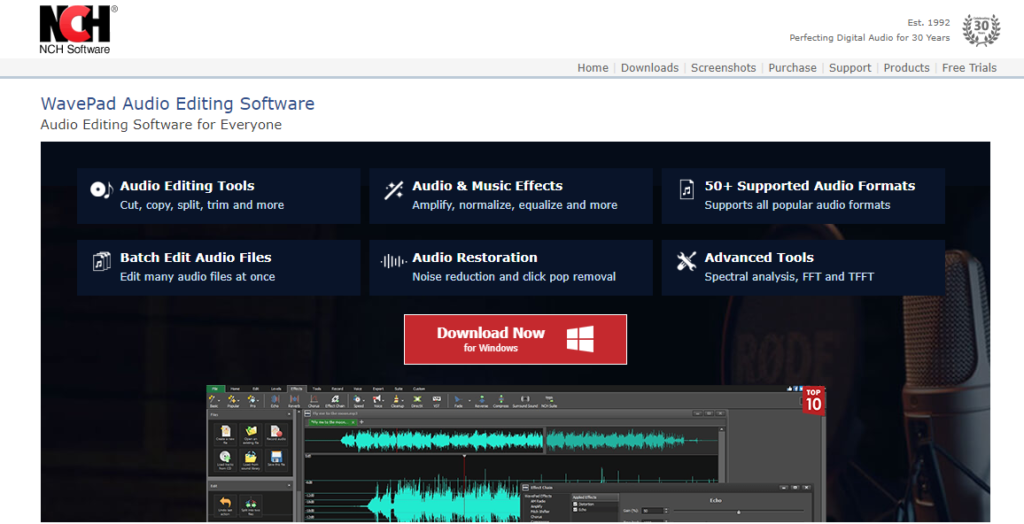
WavePad is a versatile and accessible audio editing software that provides a range of tools for recording, editing, and mastering audio files. Its intuitive interface and extensive feature set make it a popular choice for musicians, podcasters, voiceover artists, and anyone who needs to work with audio creatively and professionally.
WavePad is a versatile and user-friendly audio editing software developed by NCH Software. It’s designed for individuals who need a robust tool for editing and enhancing audio files, whether for music production, podcasting, voiceover work, or general audio editing tasks. WavePad offers a wide range of features and tools for audio recording, editing, and mastering. Here are some key features and functionalities of WavePad as an audio editing software.
Key Features:
- User-Friendly Interface: WavePad is known for its straightforward and user-friendly interface, making it accessible to both beginners and experienced users.
- Multitrack Editing: Users can work with multiple audio and MIDI tracks simultaneously, making it suitable for creating complex audio compositions and mixes.
- Audio Recording: WavePad allows users to record audio from various sources, including microphones, instruments, and external audio interfaces. It supports real-time monitoring.
- Audio Effects: The software includes a comprehensive library of audio effects and filters, such as equalization, compression, reverb, chorus, and more, for sound manipulation and enhancement.
- VST Plugin Support: Users can expand WavePad’s capabilities by adding third-party VST plugins for additional audio processing and creative effects.
- Noise Reduction and Restoration: WavePad provides tools for reducing background noise, hiss, and other audio imperfections. It also supports audio restoration tasks.
- Voice and Speech Editing: The software offers features for voice editing, pitch correction, and voice enhancement, making it suitable for podcasters and voiceover artists.
- Audio Analysis: WavePad provides tools for visualizing and analyzing audio, including waveform displays, spectral analysis, and audio statistics.
- Batch Processing: Users can apply changes, effects, or conversions to multiple audio files simultaneously through batch processing.
- Cross-Platform Compatibility: WavePad is available for both Windows and macOS operating systems, ensuring compatibility with various platforms.
- Audio Format Support: The software supports a wide range of audio formats, making it versatile for working with different audio sources and platforms.
- Export Options: Finished audio projects can be exported in various formats and quality settings to suit different distribution platforms.
- Educational Resources: WavePad offers tutorials, help documentation, and video guides to assist users in learning how to use its features effectively.
Pricing:
You can easily get started at WavePad with a free sign-up. If you want more features besides free sign-up. So you will have to step up to the paid plan. If this plan does not match your personal reasons or business, I would recommend you to drop a mail to their customer support or you can contact them directly as per availability.
Executive Summary.
1. Pricing and Licensing.
Audio editing software comes with various pricing models, including one-time purchases, subscriptions, and free options, catering to different budgets.
2. The Power of Audio in Modern Media.
Audio plays a crucial role in modern media, influencing emotions, enhancing storytelling, and contributing to the overall impact of content.
3. How Audio Editing Software Works.
Audio editing software provides a platform to import, edit, arrange, and enhance audio tracks, enabling precise control over sound elements.
4. Key Features of Leading Audio Editing Tools.
Top audio editing tools offer features like multitrack editing, real-time effects processing, noise reduction, audio restoration, and support for various audio formats.
5. Benefits of Using Audio Editing Software.
Using audio editing software offers benefits like professional sound production, efficient audio post-production, and the ability to creatively manipulate audio elements.
6. Professional Sound Production.
Audio editing software empowers musicians and sound engineers to produce high-quality audio tracks, whether for music albums, films, or podcasts.
7. Efficient Audio Post-Production.
Efficient post-production processes, including mixing, mastering, and audio cleanup, are facilitated by audio editing software.
8. Creative Audio Manipulation.
Users can creatively manipulate audio elements, such as adding effects, adjusting pitch and tempo, and creating unique soundscapes.
9. Choosing the Right Audio Editing Software.
Selecting the best audio editing software involves considering factors like compatibility, available editing and effects tools, user interface, pricing, and community support.
10. Compatibility and Platform.
Audio editing software should be compatible with your operating system and hardware, ensuring smooth performance.
11. Editing and Effects Tools.
A variety of editing and effects tools, including equalization, compression, reverb, and noise reduction, are essential for achieving desired audio outcomes.
12. User Interface and Workflow.
A user-friendly interface and efficient workflow enhance productivity and ease of use for audio editors and producers.
14. Community and Support.
A strong user community and available support resources, including tutorials and forums, can be invaluable for learning and troubleshooting.
Conclusion.
The future may bring advancements in AI-driven audio processing, immersive audio experiences, cloud-based collaboration, and enhanced mobile editing capabilities.
Audio editing software empowers users to craft, enhance, and perfect sound, transforming raw audio into polished, professional content across various media platforms.
FAQs About Audio Editing Software
What is Audio Editing Software?
Audio editing software is a digital tool that allows users to record, edit, and manipulate audio files, shaping them to meet various requirements.
Why is audio important in modern media?
Audio plays a crucial role in modern media, influencing emotions, enhancing storytelling, and contributing to the overall impact of content.
What benefits does using Audio Editing Software offer?
Using audio editing software offers benefits like professional sound production, efficient audio post-production, and the ability to creatively manipulate audio elements.
How do I choose the right Audio Editing Software?
Selecting the best audio editing software involves considering factors like compatibility, available editing and effects tools, user interface, pricing, and community support.
What is the future of Audio Editing Software?
The future may bring advancements in AI-driven audio processing, immersive audio experiences, cloud-based collaboration, and enhanced mobile editing capabilities.

